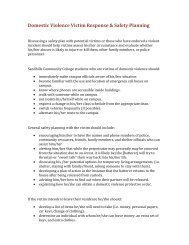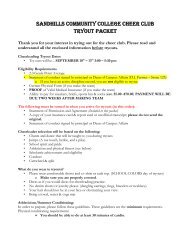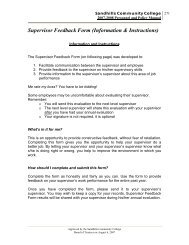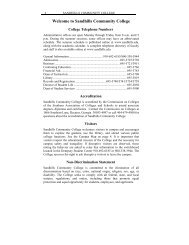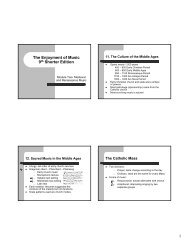Web Style Guide: TYPOGRAPHY - Sandhills Community College
Web Style Guide: TYPOGRAPHY - Sandhills Community College
Web Style Guide: TYPOGRAPHY - Sandhills Community College
You also want an ePaper? Increase the reach of your titles
YUMPU automatically turns print PDFs into web optimized ePapers that Google loves.
<strong>Web</strong> <strong>Style</strong> <strong>Guide</strong>: <strong>TYPOGRAPHY</strong><br />
This book is not a manual on HTML, and covering the full design implications of Cascading <strong>Style</strong><br />
Sheets is well beyond the scope of this chapter. If you are not using CSS to manage the graphic design<br />
of your <strong>Web</strong> site, however, you should at least be planning a transition to CSS technology within the<br />
next year.<br />
Cascading <strong>Style</strong> Sheets offer <strong>Web</strong> designers two key advantages in managing complex <strong>Web</strong> sites:<br />
●<br />
●<br />
Separation of content and design. CSS gives site developers the best of both worlds: content<br />
markup that reflects the logical structure of the information and the freedom to specify exactly<br />
how each HTML tag will look.<br />
Efficient control over large document sets. The most powerful implementations of CSS will<br />
allow site designers to control the graphic "look and feel" of thousands of pages by modifying a<br />
single master style sheet document.<br />
<strong>Style</strong> sheets provide greater typographic control with less code. Using plain HTML, you need to define<br />
the physical properties of an element such as the tag each time you use it.<br />
Section heading<br />
When you define these properties using CSS, that single definition, or rule, applies to every instance of<br />
the element in all documents that reference the style sheet.<br />
H1 { text-align: center; font-size: 16pt; font-family: Verdana, Helvetica, Arial, sansserif;<br />
color: gray }<br />
In addition, style sheets offer more formatting options than plain HTML tags and extensions. For<br />
example, interline spacing, or leading, can be controlled using style sheets, as can such text properties as<br />
letterspacing and background color. And fortunately the text formatting properties are implemented well<br />
enough across browsers to be used with some consistency.<br />
How style sheets work<br />
<strong>Style</strong> sheets are not new. Every graphic <strong>Web</strong> browser (even back to Mosaic 1.0) has incorporated style<br />
http://webstyleguide.com/type/print/type.html (5 of 31)5/17/2005 5:18:39 PM



